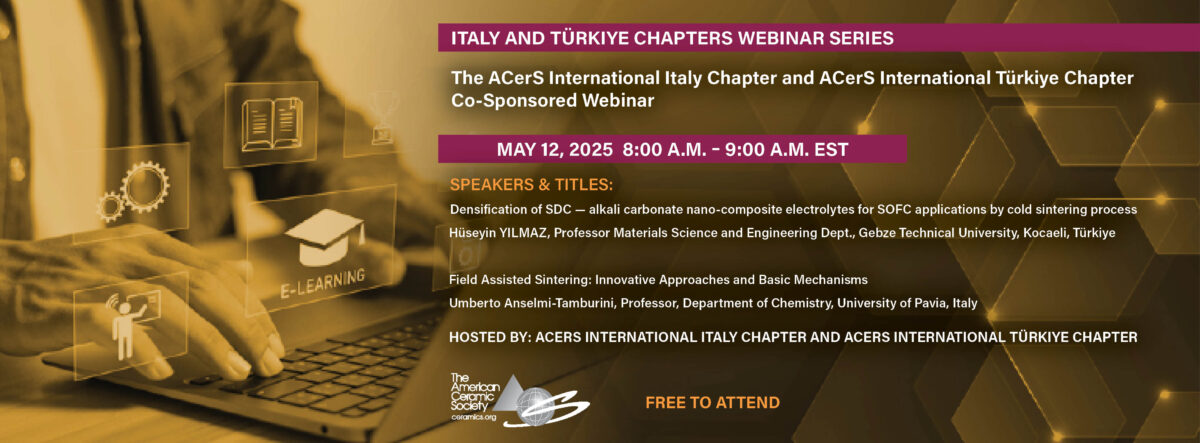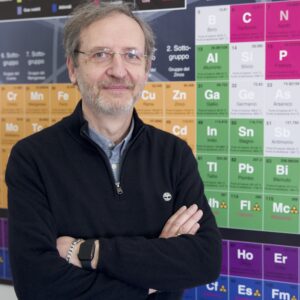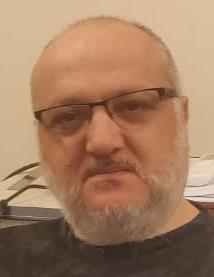Webinar Description

Hosted by: ACerS International Italy Chapter and ACerS International Türkiye Chapter
Monday, May 12, 2025; 8:00a.m. – 9:00a.m. Eastern US time
Sponsored by the ACerS International Italy Chapter and ACerS International Türkiye Chapter, the May webinar will feature two speakers: Field Assisted Sintering: Innovative Approaches and Basic Mechanisms and Densification of SDC — alkali carbonate nano-composite electrolytes for SOFC applications by cold sintering process
DESCRIPTION
Field Assisted Sintering: Innovative Approaches and Basic Mechanisms
Field-assisted sintering (FAST) and spark plasma sintering (SPS) have received widespread attention in the last two decades as tools for the densification of various materials. The reason for this success in generally related to the ability to achieve a significant reduction in sintering times and temperatures, particularly in the case of refractory or hard-to-sinter materials. Additionally, FAST/SPS also allows for obtaining compositions and microstructures that cannot be achieved by conventional sintering. This webinar will provide a brief presentation of some relevant aspects associated with these techniques. The first part will present an overview of some innovative and non-conventional applications of FAST/SPS, enabling the creation of advanced materials and microstructures. In the second part, the influence of electric fields and current on reactivity and densification will be discussed, along with their relevance in relation to the FAST/SPS processes.
Densification of SDC — alkali carbonate nano-composite electrolytes for SOFC applications by cold sintering process
Sm0.2Ce0.8O1.9- 30% Na2CO3 (Sm doped ceria (SDC)-30N) nano-composite electrolytes were densified in a single step via cold sintering process (CSP). At 200°C and 450 MPa of uniaxial pressure, samples up to 97% of their theoretical density could be obtained. The effect of processing parameters, such as temperature, uniaxial pressure, processing duration, and moisture content, on the densification of the nano-composite electrolytes was investigated. The thermal, microstructural, and electrical properties of nano-composites were investigated by differential scanning calorimetry, X-ray diffractometer, scanning electron microscope, and EIS analysis. SDC crystallite sizes were found to be around 25 nm, barely coarsened after CSP by which the true nano nature of the nano-composite could be preserved. Because, by conventional processing high density values could not be attained and high processing temperatures in excess of 600°C had to be used, promoting particle coarsening. The highest total electrical conductivity was found to be 2.2 × 10−2 S cm−1 at 600°C, with an activation energy of 0.83 eV for SDC-30N nano-composites. The present investigation revealed that the implementation of cold sintering technique resulted in significant enhancements in the densification of nano-composite electrolytes, thereby rendering them suitable for efficient utilization in SOFC applications, as compared to the conventional production methods.
BIOGRAPHIES

Umberto Anselmi-Tamburini, Professor, Department of Chemistry, University of Pavia, Italy
Umberto Anselmi-Tamburini obtained his MS in Chemistry and his PhD in Chemical Sciences at the University of Pavia (Italy). From 1986 to 1998, he served as an assistant professor in the Department of Physical Chemistry at the University of Pavia. During 1987-1988, he spent a year as a post-doctoral researcher at the University of California, Davis, as a recipient of a NATO Advanced Fellowship. From 1990 to 2009, he was an Associate Researcher at the Italian National Council (CNR), Pavia branch. Between 2002 and 2008, he was a visiting scientist in the Department of Chemical Engineering and Materials Science at the University of California, Davis. From 1998 to 2018, he held the position of Associate Professor of Physical Chemistry in the Department of Chemistry at the University of Pavia. In 2018, he became a Full Professor of Physical Chemistry in the same department.
He served as chair of the Physical Chemistry section in the Department of Chemistry at the University of Pavia from 2013 to 2025. Between 2007 and 2013, he was vice-chancellor of the University of Pavia. Since 2011, he has been a member of the National Committee for the Electronic Library Resources (CARE), appointed by the Conference of Italian Universities (CRUI). He was also the founder and president of the Pavia University Press and the Pavia Digital Archives.
His research activities include the study of the influence of nanostructure on the physical properties of bulk ionic materials; the field-assisted sintering of ionic and metallic materials; the influence of electric currents and electric fields on solid-state sintering and reactivity; the development of new methods for the deposition of thin films and nanostructures of ionic oxides from solution; the use of soft lithography and nanoimprint lithography for the synthesis of complex nanostructures; the interaction of nanostructures with biological systems; and the combustion synthesis of high-temperature materials. He authored over 220 technical papers in international peer-reviewed scientific journals, 3 EPO patents, and 3 US patents.

Hüseyin YILMAZ, Professor, Materials Science and Engineering Dept., Gebze Technical University, Kocaeli, Türkiye
Dr. Yılmaz got his Ph.D. degree from Materials Science and Engineering Department with Ceramic Science Option from The Pennsylvania State University in 2002. Since then, he has been working on ceramic powder processing through various routes. He has expertise on colloidal characterization of slurries including colloid probe technique, sintering of ceramic powders including the novel cold sintering technique, microstructural and crystallographic characterization of materials including electron backscatter diffraction technique, and electrical characterization of electroceramics like piezoceramics and ionic conductors for fuel cells. Due to his concern about environmental pollution and global warming, his main focus was on the property improvement of non-lead-based ferroelectric NBT-BT ceramics through grain orientation and high-power ultrasonic application of non-lead-based ferroelectric KNN ceramics. He believes that solid oxide fuel cells are of great importance as energy converters that could replace fossil fuels. Therefore, he has been working on developing simplified and energy efficient processing route for solid oxide fuel cells using cold sintering technique at low temperatures.
REGISTRATION
If you have any questions, please contact Vicki Evans.
This webinar is brought to you by the ACerS International Italy Chapter and ACerS International Türkiye Chapter.
To view past ACerS webinars click here.
